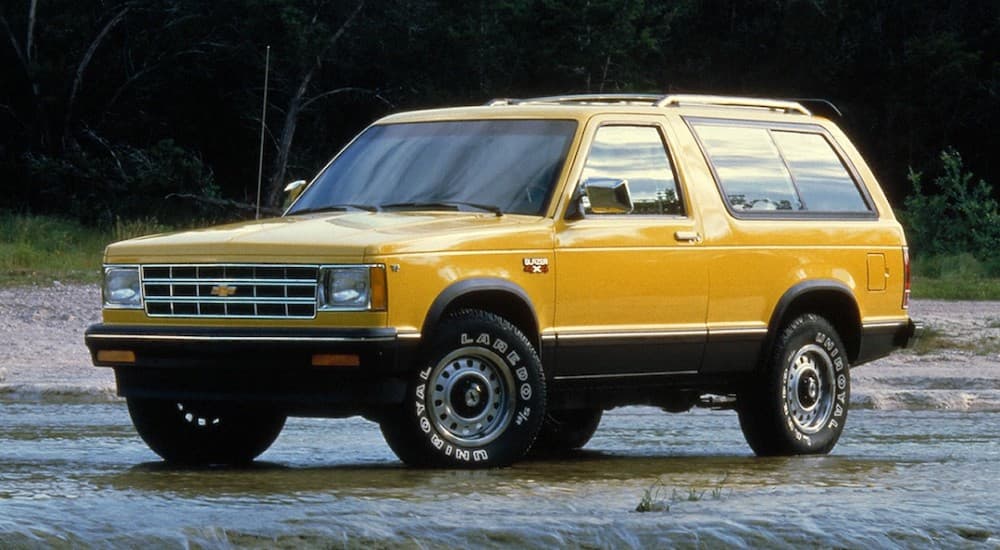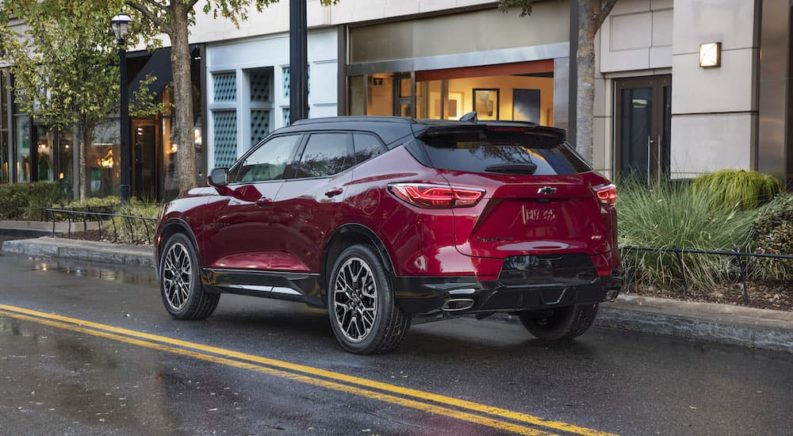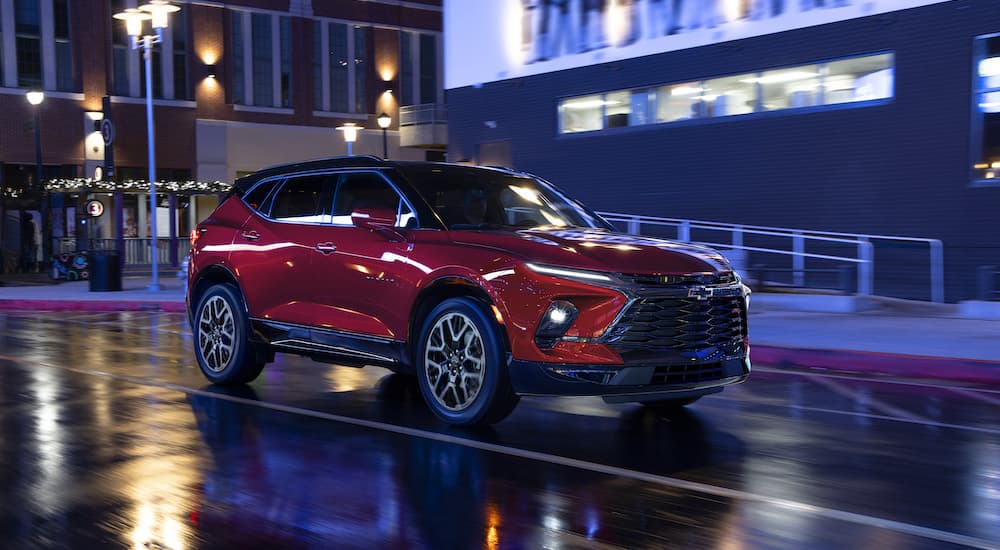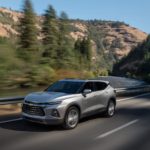If you’ve been driving for a while, you’ll have noticed that many models change over time—aesthetically, for practical purposes, or a mixture of both. One of the models that has gone through radical changes for the better is the Chevy Blazer. The 2023 Chevy Blazer has received dramatic changes to its exterior as well as interior, so we’re going to take a look at five of the changes made over the years. These updates have evolved the Blazer into a Chevy vehicle worth celebrating.
What was originally a response to the Ford Bronco, the Chevy Blazer has become one of the most striking SUVs on the road, now competing with the likes of the consistently lauded Kia Sorento. It did disappear for a while after 2005, but was reintroduced to the Chevy family over a decade later with its history intact—an off-roading vehicle like the Bronco, with the family vehicle stylings of an SUV like the Hyundai Santa Fe.
#1: 1973’s 4×4 Inclusion
The second-generation Blazer was full to the brim with changes, but perhaps the most exciting change was the move to a full-time 4×4 system. If you’re into off-roading excursions, then this is where it gets good: the full-time 4×4 system allows control over all four wheels, all the time, on any surface. This means that the Blazer controls each wheel and will shift gears on its own, depending on what is best suited for the current terrain.
So basically, the Blazer is now your best friend and co-pilot on the journey, able to switch gears in a flash as you go through mud, gravel, vegetation, desert, or soft dirt. This is especially helpful when considering just how often you run into different environments as you off-road, including inclement weather like snow, ice, and rain. This addition meant that the Blazer could be trusted in multiple situations, not just on the highway.

#2: 1982’s Inclusion of a V8 Diesel Engine
I remember when diesel was cheaper than gas, although back then I wasn’t sure what the difference was. All I knew was that there were two types of fuel: one was cheaper, and people with bigger vehicles tended to go with the diesel fuel. In the early 1980s, enough people were clamoring for diesel engines that Chevrolet decided to offer not only a diesel engine option, but a V8 diesel, meaning the Blazer was now more powerful—and, in theory, less expensive to fuel. The engine choice did come with a catch, though: Only a four-speed automatic transmission was available to pair with the diesel.
I don’t know about you, but most of the people I know who choose a diesel engine seem to prefer manual transmission, because it allows for more control, higher performance, and faster acceleration. I knew someone who always preferred manual transmission because it kept them occupied. If they were in a car with an automatic transmission, they paid less attention and found it more difficult to focus. While this pairing didn’t seem to dampen Blazer fans’ enjoyment of the vehicle, it should be noted that today’s Blazer only has one option: gas-powered, automatic transmission. As more and more people move away from manual transmission and diesel prices soar higher, it makes sense for Chevy to go with other options—though I’m sure many of you would prefer to at least have the option of a diesel-fueled, manual Blazer.
#3: 1991’s Four-Door Debut
Though it might not seem like a big change, in reality, this is what turned the Blazer from just an off-roader to the family vehicle we know it as today. I remember having to crawl behind a front seat to get to my own seat in the back, and let me tell you, there were always other siblings complaining about how slow it was to get in. It felt crowded and cramped, and then we had to rearrange ourselves while an adult fixed the passenger seat up front. Then, as soon as we were at our destination, the whole thing happened again—this time in reverse. Two more doors were a dramatic change that helped the Blazer stay popular, even though it was just optional on one trim level.
With a much easier way to get in, load up, and give everyone a little bit of independence, the Blazer became much more family-friendly—which suited the 1990s just fine, by all accounts, as many families needed a bigger vehicle to fit their growing families. While we got a two-bench pickup truck, many of my friends’ parents purchased an SUV or a minivan, depending on family size and storage requirements. Though of course, SUVs were the much more coveted vehicle, and the same remains true to this day.
#4: 1995’s Division Between Models
While there had been more than one Blazer on the market, 1995’s change made it clear. Previously, the S-10 and K5 models were both considered Blazers, but with the K5’s rebrand into the Chevy Tahoe, the S-10 was the only Blazer left on the market. To keep up with rebrands, marketing, and current design, the Blazer got a major redo, allowing it to appear sleeker, suaver, and much more suited to suburban life.
The S-10 Blazer would continue to be made until 1999, though they were being sold until 2005, but only to fleets. The Chevy Trailblazer was introduced in 1999 as a trim level, but became its own model in the early 2000s, probably because it wasn’t a “real” Blazer—it was more like a car due to its construction as a unibody vehicle. Blazer fans seemingly ran out of luck in the mid-2000s, as it was doubtful Chevrolet would revive the model. Luckily, however, it was given a second chance in 2019, and it is thriving once again as a mid-size family SUV.
#5: 2023’s Distinctive Appearance
Though the Blazer has only been back since 2019, the 2023 Chevy Blazer underwent yet another redesign, this time both inside and out to show off a new look and updated features. The newest edition of the Blazer looks sportier, fiercer, and as far removed from a boring family vehicle as possible. Most of the new exterior concerns the lighting in front and back, additional paint color choices, and new wheel designs that come in two sizes. Inside, there’s a wireless charging pad and an infotainment center that is bigger than the standard 8” seen in many other models, clocking in at 10”.
Higher trim levels have additional coveted features, like a Bose stereo system, camera systems, and a variety of engine options for those who would like the Blazer to haul up to 4,500 lbs. While the old Blazer took its cues from pickup trucks, this new edition has taken some inspiration from the Chevy Camaro, which is why this Blazer looks more like a sports car than a work vehicle.
What started as a rival of the Ford Bronco has become something else entirely: a Chevy model that stands on its own as a fun-to-drive, sporty family vehicle with plenty of room for the entire crew and any camping equipment, sports gear, or shopping bags necessary. It’s a capable vehicle, capturing plenty of attention for its looks and handling, while also providing a safe, smart interior for those longer rides. While it has seen plenty of changes over time, what this shows is that Chevy knows how to adapt, reinvent, and reimagine vehicles—so they stay fresh and up to date for the current market. What’s your opinion on the 2023 Chevy Blazer? Let me know in the comments section below.





